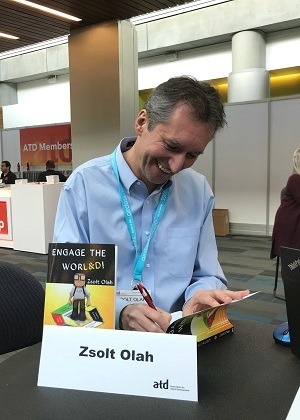5 Actionable Insights On Trends In 2018: Click Now For The Future Of Learning!
You may have seen the eLearning Trends 2018 predictions from 57 experts, including myself. Some of these predicted trends, collected by Bryan Jones, were already noticeable at the ATD TechKnowledge conference in San Jose, CA. Talking to some of the attendees, it was clear that, while everyone is excited about the future of learning, many in the field want to do something here and now. Instead of waiting for the Next button to show up, we need a Now button!
Click now, and nobody gets hurt!
And so, I collected 5 actionable insights for here and now to share with you from various sources: my session, other sessions, vendor expo floor, speakers’ room, and hallway conversations. If you want to click Now, instead of waiting for the Next button, look at some actionable insights on trends in 2018:
Neuroscience
John Medina, author of Brain Rules, a developmental molecular biologist by trade, couldn’t be more clear in his keynote speech: at this early stage of neuroscience, we should be skeptical about taking preliminary results and apply them to other fields, including L&D. That said, we dove into the realms of theory of mind.
“Theory of mind (often abbreviated ToM) is the ability to attribute mental states—beliefs, intents, desires, pretending, knowledge, etc.—to oneself, and to others, and to understand that others have beliefs, desires, intentions, and perspectives that are different from one's own.”
In brief, ToM is a framework for predicting and understanding social behavior. Of course, John Media cited every source he was referring to; a good practice L&D should be following at all times. (Including on infographics.) How do you measure ToM? One of the commonly used tools is the Reading the Mind in the Eyes (RMET)1 test. One interesting takeaway was that you can improve your theory of mind by reading good fiction. And by good, research showed improvement by reading award-winning quality authors only, where you not only put yourself in a character’s shoes, but in their well-defined, fictional mind as well.
Actionable Insight #1
Be skeptical! While there is a good body of research on how people learn, most of it comes from cognitive and behavioral science, not neuroscience. Always look for and ask for a citation! Just because something “makes sense,” it does not mean it’s true (see effectiveness of learning styles). How to improve your ToM now? Read good fiction! Be exposed to art! Reflect on literary fiction characters’ emotional state in the book you're reading! Build your empathy by reflecting on art and fiction! And no, you can’t have empathy training without emotions.
- To learn more about the fiction reading study: Reading Literary Fiction Improves “Mind-Reading” Skills Finds A Study From The New School For Social Research
- To test your ability to read emotions (light version): Can You Read People’s Emotions?
- The more scientific version of RMET (requires subscription): The “Reading the Mind in the Eyes” Test (RMET)
- Interpersonal Reactivity Index (multi-dimensional measurement of empathy)
Micro(-)learning
Everyone loves them! They’re small, nimble, and quick. They’re flexible. Although, they all might look alike, each one is perfectly tailored to deliver their respective succinct message. They’re not “chunked” versions of a whole. They are standalone, and complete in themselves. They are excellent for a cooperative and sharing community, where each one exhibits a distinct skill or knowledge. They’re cute! Yes, we all love the Smurfs!
Now, onto micro(-)learning!
- Read Shannon Tipton’s thoughts on what is and what it is not: Microlearning: The Misunderstood Buzzword
- Clark Quinn also reflects on how to define micro(-)learning: Microdesign
Both argue against one of the most common misconceptions that micro(-)learning means a short (often defined as 3-5 minute) chunked content, preferable video that you just "look up" right at the need of time. Not true! If you have a long, stinky sausage, and you chunk it to several pieces, it won’t make it a tapas dish in a restaurant. If you take a novel, and you publish each chapter, you won’t get a prize for short stories. And for the "just in time" lookup, not everything can be learned just in time (Clark Quinn also points out in the blog that it is more performance support than learning anyway.)
JD Dillon, in his session about adaptive learning, also discussed the notion of micro(-)learning. The example he mentioned was safety. A course “covering” safety might be “comprehensive,” but it is too broad to be actionable. Micro(-)learning is a targeted, right-sized approach that can be used to close certain performance gaps for those who do not lift the box properly, for example. (Note that you still need data why they’re not lifting the box properly. They don’t know what to do? They don’t know how to do it? They know what and how but they’re taking shortcuts? Under time pressure? Based on the answer, micro(-)learning may or may not be the right solution.) If you advertise micro(-)learning as a “short”, “bite-sized”, or “snackable” learning event people take just in time, it might sell well with stakeholders because you're reducing the time away from work. After all, who wants a long, chewy, fatty learning event? But, do you want to be on the plane with a captain who's learning "just in time" how to land on the Hudson? (Borrowed it from Karl Kapp.)
Actionable Insight #2
Do not start with learning in mind! Even if it’s micro! Start with curiosity in mind! Use Cathy Moore’s action mapping (or similar tools) to find out the potential cause of the performance gap. Then, apply the right combination of solutions. Always include managers and supervisors in your design. People don’t learn and work in a vacuum. Reinforcement often comes (or does not come) from management!
Augment Reality (AR) / Virtual Reality (VR)
Are you bored with reality? Well, according the leading trends, 2018 is predicted to be the year for AR and VR going mainstream. While we tend to mention these two approaches together, they serve different purposes. Augmented Reality adds a computer-generated layer to reality (think Pokémon), while Virtual Reality completely transforms you into a lifelike 3D world.
They both have one thing common, though: user experience! You may read articles, or watch videos about AR/VR solutions, but it is not the same as actually experiencing them for real. I talked to many people at the ATD TK conference who said they were skeptical about AR/VR, but after experiencing them in first hand, now they get it. If you haven’t played with AR/VR, I encourage you to try it out. Especially VR. It will change your perception of reality!
Actionable Insight #3
Build your first AR experience using apps like Zappar or Blippar. Zappar offers a free account and, within hours, you’re ready to explore bringing static objects alive.
What can you do with Zappar?
- Augment your paper: Simple AR: Bring Paper Alive
What else can you use it for? Performance support to handouts, cheat sheets, manuals, even mouse pads. You can even build a scavenger hunt activity for a team meeting that combines physical object (outdoor or indoor) and augmented knowledge (see example).
Adaptive Learning / Artificial Intelligence (AI)
If I had to sum up the value of adaptive learning (often powered by AI) in one word, I’d say it is relevance. Relevance is a multi-dimensional concept. In the most simplistic way, it’s about time and space. The ability to provide adequate learning when it is needed and where it is needed, is a key to the success of any organization.
JD Dillon walked the audience through his 4 dimensions of adaptive learning in a session. In Smurfland, you have all four perfectly lined up: data, content, tech, and person. In reality, we’re far from getting there. Yet, every journey starts with the first (adaptive) step. If nothing else, start with the content. Delivering content that is relevant to the user might be as simple as selecting a choice that describes their role best, rather than going through the same content.
I also wanted to mention Artificial Intelligence (AI) here. Every decent platform dealing with data nowadays claims to have AI embedded. A commerce site might recommend products that “people like you” also bought. The question is, who are “people like you?” What data is the application using to categorize users to find similarities? How frequently is the data collected? How relevant are the data points to the purchase? Serving courses based on what other people take once a quarter, may not be a good idea.
Because here’s a thing: the “people who bought this product, also bought” approach is not AI. It’s SQL (simple database query). That’s simply retrieving data. What AI can do is find patterns that you don’t see in the data, aggregated from various sources. If AI can predict what you will buy next, that’s a different story (although, it can be interesting). Finding relevant items for a user based on similar behaviors is more complex that it seems. Read this paper on novelty, for example.
Actionable Insight #4
Make learning relevant! Missing this very step (more on engagement in my previous article) can jeopardize your success to engage your audience, no matter what delivery method you’re using. If nothing else, build your content modular enough for users to be able to match their needs without digging through irrelevant content. It can be as simple as a pre-assessment quiz that highlights areas of knowledge gaps, or a choice to receive customized learning experience by role. Start with small steps and keep going!
Games And Gamification
Have you ever suffered through a presentation where the speaker was talking about how not to use boring bullet points in presentations? And there it is, the first bullet point: not to use boring bullet points?
What I like about Karl Kapp’s sessions is that he’s not just talking about games and gamification for learning. He’s doing it. The session itself is designed to be gameful. Don’t wait until your organization purchase as “gamification platform.” Game thinking is free.
Actionable Insight #5
Play games! Without playing different types of games, it is simply not possible to think like a game designer. And playing is not enough! Analyze them! What makes them engaging? How do they gradually change the level of difficulty? How do you get feedback? How often? What makes you come back to play more? If you’re new to games for learning, I suggest reading Play to Learn by Sharon Boller and Karl Kapp.
Speaking Of My Book…
The biggest L&D book heist in history just happened! USPS successfully delivered the box top with the tracking label to the conference for my book signing. I mean it. The box top. Without the bottom of the box. Also missing: 12 books in between the top and the bottom. Watch the L&D black market for my books!
As usual, I took this as a lesson learned from life: measuring the wrong thing (as in tracking the label) may provide good stats, but it might not have anything to do with achieving the business goal (delivering the books). Engage the WORL&D! is available at Amazon, or somewhere in a distant USPS facility.

Bonus Action
My session was a two-hour hands-on advanced Storyline (here’s more on that). Some of the participants asked how they could improve their skills using the tool. The best way to do that is participating in the Articulate eLearning Heroes weekly challenge.
Footnote:
- Warrier V., Bethlehem R.A., Baron-Cohen S. (2017) The “Reading the Mind in the Eyes” Test (RMET). In: Zeigler-Hill V., Shackelford T. (eds) Encyclopedia of Personality and Individual Differences. Springer, Cham

